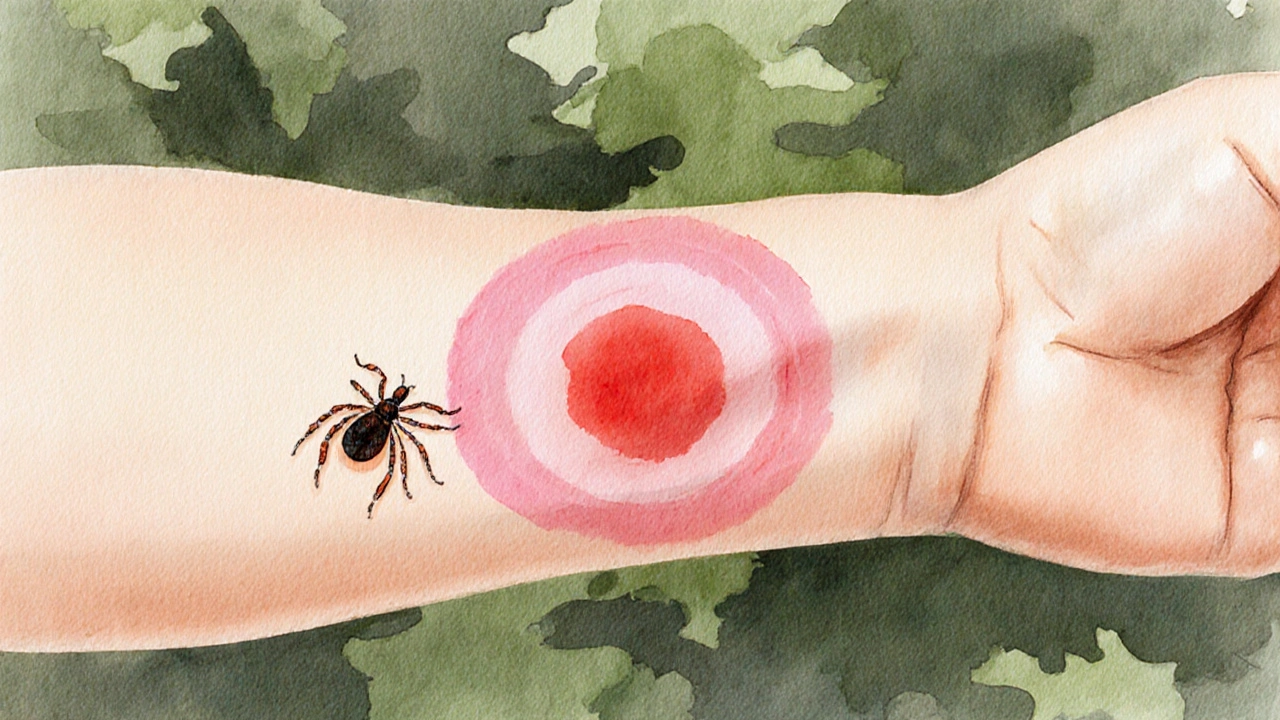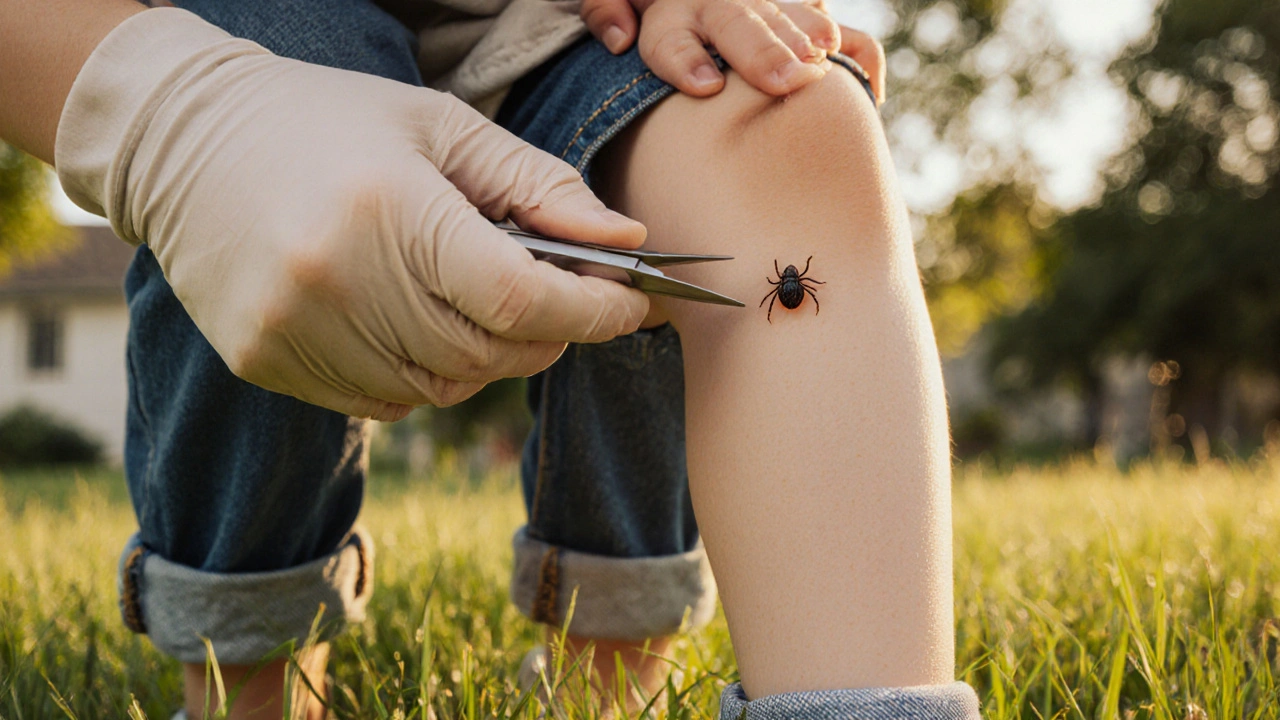Tick Fever Symptom Checker
Symptom Assessment
Select all symptoms your child is experiencing:
Risk Assessment Results
When a tiny insect can cause a high fever, rash, or worse, parents naturally feel alarmed. Tick fever is a blanket term for several tick‑borne illnesses that can affect children, including Lyme disease, Rocky Mountain spotted fever, and ehrlichiosis. Understanding how these bugs spread, what to watch for, and how to act fast can keep your little ones safe.
Quick Take
- Check for ticks daily during warm months, especially after outdoor play.
- Early symptoms include fever, headache, and a rash that looks like a bull’s‑eye.
- Prompt treatment with doxycycline (or alternatives for very young kids) works in most cases.
- Use EPA‑registered repellents and dress kids in long sleeves to prevent bites.
- If a tick has been attached for more than 24hours, seek medical care immediately.
What Is Tick Fever?
Tick fever isn’t a single disease; it’s a collection of infections transmitted when a tick inserts its mouthparts into the skin and feeds. The most common culprits in North America are:
- Lyme disease - caused by Borrelia burgdorferi, spread mainly by the black‑legged Ixodes scapularis tick.
- Rocky Mountain spotted fever - a rickettsial infection from Rickettsia rickettsii, transmitted by the American dog tick (Amblyomma americanum) and the Rocky Mountain wood tick.
- Ehrlichiosis - caused by Ehrlichia chaffeensis, also spread by the lone‑star tick (Amblyomma americanum).
All three can produce fever, headache, and a rash, but the exact pattern and severity differ. For kids, the biggest risk is delayed diagnosis, which can lead to joint problems or neurological issues.
How Children Get Infected
Kids spend a lot of time playing in grassy fields, forests, and even backyard gardens-perfect habitats for ticks. A tick must stay attached for at least 6‑12hours for most pathogens to pass, but the longer the bite, the higher the chance of infection.
- Ticks climb onto clothing or fur and wait for a host.
- They crawl onto skin and insert their feeding tube.
- While sucking blood, they can release bacteria or rickettsiae.
Because many species are tiny (the nymph stage of Ixodes scapularis is less than 2mm), children often don’t notice them.
Signs & Symptoms to Watch
Symptoms can appear anywhere from 3days to 2weeks after the bite. Here’s a quick checklist for parents:
- Fever ≥38.5°C (101.3°F) that won’t break.
- Headache or stiff neck.
- Fatigue or irritability.
- Rash:
- Lyme - a red, expanding “bull’s‑eye” lesion (erythema migrans).
- Rocky Mountain spotted fever - small red spots that may turn into a petechial rash, often on wrists and ankles.
- Ehrlichiosis - a maculopapular rash, sometimes on the trunk.
- Joint aches, especially in the knees.
- Nausea, vomiting, or abdominal pain.
If any of these appear after a known tick exposure, call your pediatrician right away.

How Doctors Diagnose Tick Fever
Diagnosis combines a clinical exam, history of tick exposure, and lab tests. Typical steps include:
- Physical exam focusing on rash patterns and lymph node enlargement.
- Blood tests: enzyme‑linked immunosorbent assay (ELISA) for Lyme antibodies, polymerase chain reaction (PCR) for Rickettsia DNA, and complete blood count (CBC) to spot low platelets (a sign of Rocky Mountain spotted fever).
- Sometimes a skin biopsy of the rash helps confirm rickettsial infection.
Because early labs can be negative, doctors may start treatment based on suspicion alone-especially in children under eight where delays are risky.
Treatment Options for Kids
Antibiotics are the mainstay, and most children respond quickly if therapy begins within a few days of symptom onset.
| Illness | First‑line Antibiotic | Typical Dose (children) | Duration |
|---|---|---|---|
| Lyme disease | Doxycycline (≥8years) or Amoxicillin (<8years) | 4mg/kg twice daily (doxy) / 50mg/kg/day divided | 10‑21days |
| Rocky Mountain spotted fever | Doxycycline (all ages) | 2.2mg/kg every 12h | 7‑10days |
| Ehrlichiosis | Doxycycline | 2.2mg/kg every 12h | 7‑14days |
For children under eight, doctors may still prescribe doxycycline because studies show it’s safe and far more effective than alternatives for serious tick‑borne diseases. Side‑effects like stomach upset are usually mild and can be eased with food.
Prevention Strategies Parents Can Use
Stopping a tick bite beats treating a fever any day. Here are proven tactics that fit into a busy family routine:
- Dress smart: Long sleeves, long pants, and tucked‑in shirts create a barrier. Light‑colored clothing helps you spot ticks.
- Use EPA‑approved repellents: Products containing 20‑30% DEET, picaridin, or IR3535 are safe on kids over 2 months.
- Check and remove ticks promptly: Run a fine‑toothed comb or gloves over the skin. Grasp the tick as close to the skin as possible and pull straight up with steady pressure. Disinfect the site afterward.
- Landscape for safety: Keep grass trimmed, remove leaf litter, and create a wood‑chip barrier between lawns and wooded areas to discourage ticks.
- Vaccinate pets: Dogs and cats can carry ticks into the yard. Keeping them on tick‑preventive medication reduces the overall tick load.
Even with these steps, a bite can still happen. That’s why a quick post‑bite protocol matters.
What to Do After Finding a Tick
- Note the date and exact location of the bite.
- Safely remove the tick using tweezers or a tick‑removal tool.
- Grab the tick as close to the skin as possible.
- Pull upward with steady, even pressure-no twisting.
- Clean the area with soap and water, then apply an alcohol wipe.
- Save the tick in a sealed bag (optional but helpful for lab testing).
- Monitor your child for fever, rash, or flu‑like symptoms for the next 30days.
- If the tick was attached for more than 24hours, or if symptoms appear, call your pediatrician immediately. Early prophylactic doxycycline can be prescribed within 72hours of removal for high‑risk exposures.
Most parents think a single bite is harmless, but the CDC recommends a single dose of doxycycline for children over eight if the tick was a known carrier and was attached for longer than 36hours.
When to Seek Emergency Care
While most cases are treated on an outpatient basis, these red‑flag signs warrant urgent attention:
- Persistent fever above 39°C (102.2°F) for more than 48hours.
- Severe headache, neck stiffness, or confusion.
- Rapidly spreading rash or bruising.
- Difficulty breathing or swallowing.
- Unexplained vomiting, severe abdominal pain, or signs of dehydration.
Emergency treatment may involve IV antibiotics and supportive care.

Frequently Asked Questions
Can a child get Lyme disease from a tick bite in Canada?
Yes. While Lyme disease is most common in the Atlantic provinces and parts of Ontario, cases are reported across Canada each year. Early detection and treatment are critical to avoid joint and neurological problems.
Is doxycycline safe for children under eight?
Recent guidelines from the CDC and AAP say doxycycline is safe for short courses in children of any age when treating serious tick‑borne infections. The benefits outweigh the small risk of temporary tooth staining.
How can I tell if a tick is infected?
You can’t see the pathogen with the naked eye. The safest approach is to assume any attached tick could carry disease and act accordingly-remove it promptly and monitor for symptoms.
Do ticks bite indoors?
It’s rare, but ticks can hitch a ride on pets or clothing and end up inside homes. Regularly check pets and wash bedding after outdoor trips to reduce indoor exposure.
Should I give my child over‑the‑counter pain relievers for fever?
Acetaminophen or ibuprofen can be used to control fever and discomfort while you arrange medical care. They don’t treat the underlying infection, so they’re a temporary measure.

Rakesh Manchanda
October 3, 2025 AT 05:35Ensuring that our children are shielded from tick‑borne fevers begins with a meticulous daily ritual; a quick glance over their limbs after every adventure can make the difference between a carefree summer and a hospital visit. While some may deem such vigilance excessive, the epidemiological data unequivocally underscores the perils of complacency. In regions where Ixodes scapularis thrives, the prevalence of Borrelia burgdorferi has risen sharply, translating to a higher incidence of pediatric Lyme disease. A proactive approach, involving the use of EPA‑registered repellents and the adoption of long‑sleeved attire, forms the first line of defense. Moreover, educating children about the subtle nature of nymphal ticks-often invisible to the naked eye-empowers them to participate in their own safety. Finally, retaining a tick removal tool at home ensures that any unwelcome visitor can be extracted promptly, thereby curtailing pathogen transmission.
Erwin-Johannes Huber
October 7, 2025 AT 20:42Check for ticks daily and act fast.
Tim Moore
October 13, 2025 AT 01:42In the broader context of vector‑borne illnesses, it is incumbent upon caregivers to assimilate both clinical vigilance and preventive stratagems. First, an exhaustive inspection of the child’s skin should ensue following any outdoor exposure, with particular attention to intertriginous zones where ticks may embed unnoticed. Second, the employment of repellents containing DEET or picaridin has been substantiated by peer‑reviewed studies to diminish attachment rates significantly. Third, protective clothing-preferably of a light, breathable fabric-serves as a mechanical barrier, especially in endemic habitats such as woodlands and tall grasses.
Should a tick be discovered attached for a duration exceeding twenty‑four hours, immediate medical consultation is warranted, as the probability of pathogen transmission escalates markedly beyond this temporal threshold. Laboratory diagnostics, while valuable, may yield false negatives in the incipient phase; consequently, empiric antibiotic therapy is often initiated based on clinical suspicion alone, particularly in pediatric cohorts where delayed treatment correlates with adverse sequelae.
Finally, ongoing education regarding the epidemiology of tick‑borne diseases-acknowledging regional variations in pathogen prevalence-fortifies community resilience and reduces the burden of preventable morbidity. By integrating these evidence‑based measures, parents can markedly attenuate the risk of tick fever and safeguard the health of their offspring.
Erica Ardali
October 18, 2025 AT 12:15One must ponder the existential irony of a creature so diminutive wielding the power to upend the innocence of childhood. The tick, a humble arthropod, masquerades as a benign companion of the forest yet carries within its minuscule body the seeds of fever, rash, and relentless torment. In the grand theater of nature, we are but actors forced to confront the silent menace that clings to our progeny, demanding vigilance beyond the realm of complacency. It is not merely a medical concern but a philosophical challenge: to recognize the fragile interdependence of life and to respond with measured resolve, rather than surrender to the careless whims of chance.
Justyne Walsh
October 23, 2025 AT 22:48Ah, another lofty rumination about a bug-how quaint. While you wax poetic about existential dread, the practical truth remains: parents need concrete steps, not metaphysical musings. So strip away the drama and remember: check, repel, and act within 24 hours, or face the inevitable consequences of ignoring common sense.
Susan Cobb
October 29, 2025 AT 12:08People often overlook the fact that not all tick fevers present with a classic bull's‑eye rash; in fact, many cases manifest merely with nonspecific malaise, leading clinicians to miss the diagnosis. Moreover, the duration of attachment required for transmission varies between pathogens, rendering a blanket "six‑hour rule" misleading. Consequently, a nuanced understanding of vector biology is essential for any responsible caregiver. Lastly, reliance on over‑the‑counter tick repellents without checking the active ingredient may provide a false sense of security.
Ivy Himnika
November 4, 2025 AT 01:28Proper grammar is as vital as proper tick removal; misplacing a comma can obscure a critical health warning. When drafting a checklist for parents, ensure each bullet is succinct, parallel, and free of ambiguity. For instance, write "Apply EPA‑registered repellent" rather than "apply repellant". Consistency in diction mirrors consistency in preventative measures 🛡️.
Nicole Tillman
November 9, 2025 AT 14:48Building on the previous point, clarity in communication directly influences parental adherence to safety protocols. When instructions are linguistically precise, the likelihood of correct implementation rises, thereby reducing the incidence of tick‑borne disease. Hence, we must regard linguistic rigor as a public‑health instrument, as much as any vaccine or antibiotic.
Sue Holten
November 15, 2025 AT 04:08Sure, we can keep talking about how to dress kids like tiny generals in camo, but the reality is kids will still get into the grass and you’ll end up with a tick on their ankle anyway. So maybe just accept that nature is messy and focus on the after‑care instead of the fashion statements.